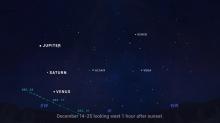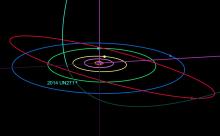Listen to today's episode of StarDate on the web the same day it airs in high-quality streaming audio without any extra ads or announcements. Choose a $8 one-month pass, or listen every day for a year for just $30.
You are here
Lexell’s Comet
In 1770, Earth dodged a big bullet. A comet several miles in diameter passed just 1.4 million miles away. It was the closest observed approach by a comet in history.
Lexell’s Comet was discovered 250 years ago today. Comet hunter Charles Messier had just finished looking at Jupiter. He turned his telescope toward the constellation Sagittarius, to study some “fuzzy” objects he’d discovered there earlier. And he saw a new fuzzy object — a comet.
The comet quickly grew larger and brighter. By late June, it was an easy target for the unaided eye. Its coma — a cloud of gas and dust around its icy body — spanned several times the width of the Moon. The comet didn’t show much of a tail, though.
Lexell’s Comet passed closest to Earth on July 1st. Had it hit our planet, it was big enough to cause destruction on a global scale. Instead, though, it passed on by, then swung around the Sun and back into the outer solar system — never to be seen again.
Anders Johan Lexell later calculated its orbit, so the comet was named in his honor. Lexell found that the comet probably was hurled our way by a close encounter with Jupiter, the largest planet in the solar system. A second encounter, in 1779, then pushed it away from Earth.
A study a couple of years ago found that an asteroid discovered in 2010 could be the famous comet. But the evidence isn’t strong enough to be certain. So the search for Lexell’s Comet continues.
Script by Damond Benningfield






